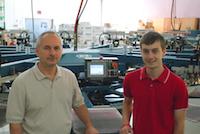by Geoff Baxter
You've had a great year, and you've invested in a new manual press, dryer, and exposure system, but there's still money left in the bank. Your accountant says you've either got to invest it or give it to Uncle Sam. You've spent a lot of time at tradeshows coveting those sleek, fully automatic presses. But there are so many types, sizes, brands, and shapes that you're baffled.
Where do you start?
We'll look at various types of automatic textile presses, as well as important pre-purchase considerations.
Why Automate?
Purchasing an automatic press is a logical step in the life of any textile screen printer. It is virtually impossible to grow and prosper in today's competitive market without the efficiency and control afforded by automated equipment.
If all of your work is one-color, then a manual press may be as efficient as—and more cost-effective than—an automatic. However, each additional manually-printed color increases the labor intensity by one factor. For example, a two-color print is twice as labor intensive as a one-color, and a three-color is three times as labor intensive as a one color. But an automatic press produces one finished shirt per index, whether the shirt is one color or as many colors as the press can produce.
The automatic press also allows a high level of control over print variables, and the added control will be evident in the quality of the finished print. This is especially true with dark garments and four-color process designs.
Last, but certainly not least, automatic presses reduce repetitive motion injuries like Carpal Tunnel Syndrome.
Why automate? It's obvious: Increased productivity, increased quality, and increased safety!
General Considerations
When purchasing printing equipment, you need to strike a balance between features and economics.
1. Number of Colors
The press needs to fit into your budget, yet allow you to accept the majority of work that comes in the door. Don't buy less press than you need. You certainly don't want to purchase a 6-color press, only to have to turn down an 8-color job for 10,000 shirts the next day.
As a rule, purchasing anything smaller than an 8-color automatic is probably a mistake. If you can see far enough into the future to know you will never print more than 6 colors with a flash then an 8-color might be a good choice. However, chances are you will eventually be offered contract work where you are not in control of art preparation, and that will likely require a larger machine.
Keep in mind that many presses have to give up a printhead to make way for a flash. And, for optimal results, you may also need to leave the printhead directly after the flash empty so it can be used as a cool-down station. The loss of two stations can effectively turn a 6-color press into a single-flash 4-color press.
If cost is the overwhelming factor, you may want to consider a 10, 12, 14, or even 16-station press, but equip it with just six or eight printheads. This will allow you to expand your press as your needs and finances grow. While printheads can often be purchased and added at a later date, the number of stations cannot.
2. Imprint Area
The effective imprint area is also a key consideration. Imprint areas variy from a nominal 41 x 41 cm (16" x 16") on small startup machines to 61 x 91 cm (24" x 36") for jumbo presses, and 91 x 109 cm (36" x 43") for machines with all-over printing capability. Before deciding, consider not only the work you've been doing, but also the work you hope to attract. Then, build in a cushion. As with color capacity, it's important to make sure you have the all the imprint area you'll need.
Some manufacturers offer machines with adjustable stroke length. While this may not appear to be important, the ability to shorten the stroke when printing smaller images (like pocket imprints) can greatly increase production yields. If you print small images—or plan to—you need to consider print stroke.
3. Physical Configuration
Textile presses have long been available in round and oval formats, and M&R has just come out with an inline textile press. All three formats can produce imprints of equal quality at approximately the rate. Each has unique attributes, but the most important consideration may have less to do with those attributes, and more to do with space constraints. For example, I recently designed a layout for a customer with a new, 2787 square-meter (30,000 square-foot) facility. Unfortunately, the building had a support column every 4.3 meters (14 feet) in one direction, and every 4.9 meters (16 feet) in the other. The work required 10-color jumbo presses, and because of the constraints of the columns, we had no option but to use oval presses. However, in many situations, round presses take up less total floor space than their oval counterparts.
4. Drive Systems
Textile presses have historically been available in three drive systems: hydraulic, pneumatic, and electromechanical—or some combination of the three. Hydraulics has become outdated technology, and is no longer available on new presses.
Pneumatic drives offer a good cost-to-value ratio, and are normally accurate and reliable. When purchasing air-driven equipment, however, keep in mind that you will need to budget for the cost of a compressor and a chiller (air dryer). The latter cannot be considered an option since it's a critical component in press performance and longevity. In addition, most manufacturers will not honor the warranty if a chiller is not in use.
Electromechanical machines make up the top 10% of the market. These systems utilize state-of-the-art technology to produce the best quality prints at astounding speeds. This technology comes at a price, however, with top-of-the-line machines costing $150 000, or more.
5. Optional Features
Some options can be real assets, and should be carefully considered. The most notable include:
- Missing shirt detectors identify empty pallets, which are usually due to the operator having missed a load. The detector suspends operation of each printhead in sequence as the empty pallet passes underneath. This is a must-have.
- Automatic startup/shutdown mode. This feature is now standard equipment on many presses. In this mode, the machine will turn the active printheads on automatically as the first shirt begins its journey around the press, and then turn them off as the last shirt complete the print run. This is a great feature.
- Automatic test print. In test print mode, one shirt is loaded onto the #1 pallet. That pallet is then automatically cycled around the press and printed. This is a great help with setup.
- Central off-contact allows the operator to adjust the off-contact distance on all printheads with a single adjustment. This is particularly helpful if you often find yourself switching from tees to sweats—and back.
- Pneumatic screen lockdowns. These small air cylinders allow you to lock a screen in place with the flick of a switch. This is a nice feature, but not absolutely necessary unless you are using a pre—registration system—something no automatic press should be without.
- Data storage allows you to store all of the parameters—including off-contact, squeegee pressure, and squeegee speed—for a specific job, and then reload the data later for repeat jobs.
6. Manufacturers
The last consideration should, perhaps, be the first. When I started in this business, life was simple. You had a choice between Advance and Precision. One was round and one was oval. Now, however, there are many manufacturers of automatic garment presses. Some offer quality products with quality service—and some don't.
I advise you to shop around. When you see a press you like, ask the dealer for references. Talk to as many people as you can who run that press. Don't just look at the price and the bells and whistles; consider the reliability of that press; the quality and quantity of support and service provided by the manufacturer; and the level of customer satisfaction (how many of the operators you talk to have purchased—or would purchase—a second or third machine?). Last, but not least, consider the longevity and fiscal stability of the manufacturer. After all, an unbelievable price and all the bells and whistles in the world are no good if your press goes down and there's no one standing behind it.
The move into automation, when properly thought out and researched, should be the next step on the path to growth and increased profitability for you and your company.
© 2004 Geoffrey Baxter
Duplication without written consent of the author is prohibited.

About the Author
- Email Address geoff.baxter@mrprint.com
- Phone 630-487-0065
Geoff Baxter previously served as President and co-founder of Atlantic Screen Supply, Inc. His 30-year industry career includes management positions with Logo-7, Harlequin Nature Graphics, Advance Process Supply Co., and Precision Screen Machines. He has also written numerous articles for trade publications and lectured at many industry events.
Geoff can be reached at geoff.baxter@mrprint.com.




